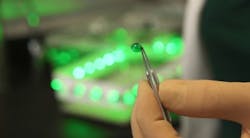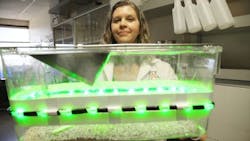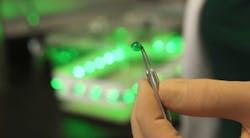Green LED light exposure may lead to chronic pain treatment
A team of researchers at the University of Arizona (UA; Tempe, AZ) revealed that rats with neuropathic pain that were exposed to green light from light-emitting diodes (LEDs) showed more tolerance for thermal and tactile stimulus.
Related: Low-Level Light Therapy—Photobiomodulation takes the spotlight
To receive the green LED exposure, one group of rats was placed in clear plastic containers that were affixed with green LED strips, allowing them to be bathed in green light. Another group of rats was exposed to room light and fitted with contact lenses that allowed the green spectrum wavelength to pass through the lenses.
Both of these groups benefited from the green LED exposure. However, another group of rats was fitted with opaque contact lenses, which blocked the green light from entering their visual system. These rats did not benefit from the green LED exposure.
The results of the study revealed that rats with neuropathic pain that were exposed to green LED light showed more tolerance for thermal and tactile stimulus than the rats that were not. Of note, no side effects from the therapy were observed, nor was motor or visual performance impaired. The beneficial effects lasted for four days after the rats' last exposure to the green LED light. In addition, no tolerance to the therapy was noted.
"While the pain-relieving qualities of green LED are clear, exactly how it works remains a puzzle," says Rajesh Khanna, UA associate professor of pharmacology and senior author of the study. "Early studies show that green light is increasing the levels of circulating endogenous opioids, which may explain the pain-relieving effects. Whether this will be observed in humans is not yet known and needs further work."
Now, the researchers are now conducting a small, randomized, double-blind clinical trial to study the effects of green LED light on people with fibromyalgia, a common source of chronic pain. Participants are provided with a green LED light strip to use in a darkened room for 1-2 hours nightly for 10 weeks.
So far, the results of the trial look promising. Two participants even refused to return the green LED light because their pain was markedly diminished. Also of note, the therapy works equally well in males and females, Khanna says. "There's no lesser efficacy in females, and that's exciting because some medications will have some pain relief and that may be further stratified based on gender," he says.
Todd Vanderah, professor and chair of pharmacology and co-author of the study, says that novel nonpharmacological methods are desperately needed to help the millions of individuals suffering from chronic pain. The initial results, hinting of green LED altering the levels of endogenous substances that may inhibit pain and possibly decreasing inflammation of the nervous system, are a great breakthrough, he says. Such therapy is inexpensive and could easily be used worldwide.
Full details of the work appear in the journal Pain; for more information, please visit http://dx.doi.org/10.1097/j.pain.0000000000000767.


